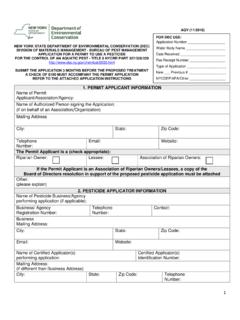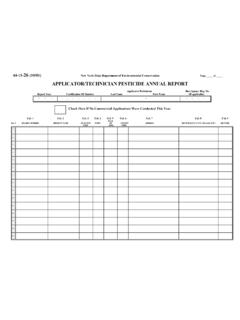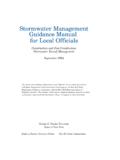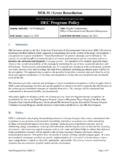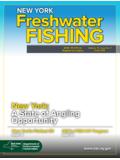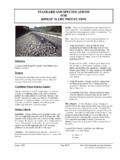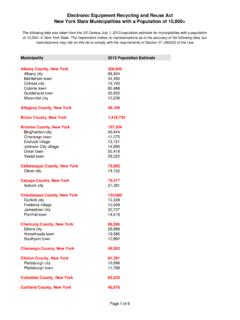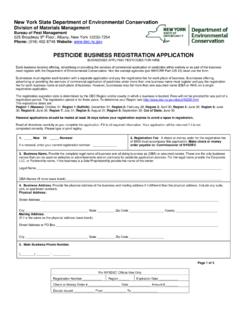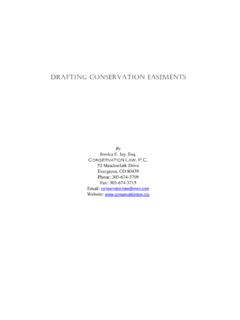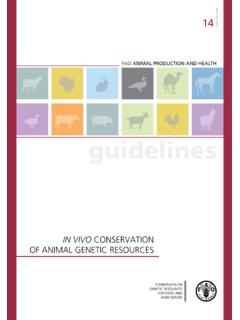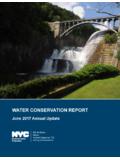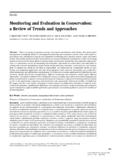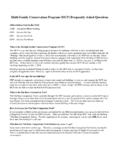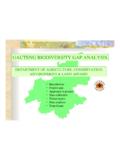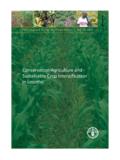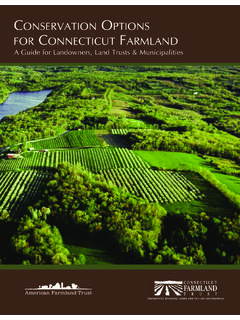Transcription of NYS Bald Eagle Conservation Plan
1 NYS Bald Eagle Conservation PlanMission of the Bureau of Wildlife To provide the people of New York the opportunity to enjoy all the benefits of the wildlife of the State, now and in the future. This shall be accomplished through scientifically sound management of wildlife species in a manner that is efficient, clearly described, consistent with law, and in harmony with public need. Goals of the Bureau of Wildlife Goal 1. Ensure that populations of all wildlife in New York are of the appropriate size to meet all the demands placed on them. Goal 2. Ensure that we meet the public desire for: information about wildlife and its Conservation , use, and enjoyment; understanding the relationships among wildlife, humans, and the environment; and clearly listening to what the public tells us.
2 Goal 3. Ensure that we provide sustainable uses of New York s wildlife for an informed public. Goal 4. Minimize the damage and nuisance caused by wildlife and wildlife uses. Goal 5. Foster and maintain an organization that efficiently achieves our goals. NYS Bald Eagle Conservation plan 2015 Page 3 Table of Contents Mission of the Bureau of Wildlife .. 3 Goals of the Bureau of Wildlife .. 3 Table of Contents .. 4 List of Tables .. 5 List of Figures .. 5 List of Appendices .. 6 Acknowledgments .. 7 Executive Summary .. 8 Introduction .. 11 Legal Mandate .. 11 Natural History .. 12 Historical Status Assessment.
3 14 Current Status Assessment .. 18 Threats to Species .. 22 Confidence Level .. 27 Current Recovery/ Conservation Efforts .. 27 Conservation Strategy and 31 Literature Cited .. 47 Appendix 1. List of terms used in the Bald Eagle Conservation plan .. 53 Appendix 2. Links to Bald Eagle References and Recommended Reading .. 54 NYS Bald Eagle Conservation plan 2015 Page 4 List of Tables Table 1. Recovery Objectives (Nye 1987).. 16 Table 2. Alphabetical listing of threat categories to bald eagles in New York State .. 23 Table 3. Sample of causes of injury or death for eagles recovered in New York State 2007-2013.
4 26 Table 4. Nesting Bald Eagle Sensitivity to Human Activities (USFWS 2007) .. 32 Table 5. Recommended Buffers Based on Proposed Activity and Site Conditions to Prevent Disturbance .. 37 List of Figures Figure 1. Bald Eagle Range (USFWS and The Birds of North America 2009) .. 12 Figure 2. Verified Historic Nesting Locations of Bald Eagles .. 15 Figure 3. NYS Bald Eagle Productivity (Nye 2010) .. 16 Figure 4. Location of New York State Bald Eagle Territories through 19 Figure 5. New York State Breeding Bird Atlas 2000-2005: Species Distribution Map (Nye 2008a).. 19 Figure 6. Estimated Number of Bald Eagle Breeding Pairs in the lower 48 states (USFWS 2007).
5 20 Figure 7. States in Red Include Nesting Locations of Bald Eagles Fledged In New York .. 20 Figure 8. Breeding Trend in New York (Nye 2008a) .. 21 Figure 9. New York State Bald Eagle Wintering Areas .. 40 Figure 10. Numbers of Bald Eagles Observed on Mid-Winter Surveys (Nye 2010) .. 43 NYS Bald Eagle Conservation plan 2015 Page 5 List of Appendices Appendix 1. List of terms used in the Bald Eagle Conservation plan .. 53 Appendix 2. Links to Bald Eagle References and Recommended Reading .. 54 NYS Bald Eagle Conservation plan 2015 Page 6 Acknowledgments This document was prepared by: Bald Eagle Team Bureau of Wildlife Division of Fish, Wildlife & Marine Resources New York State Department of Environmental Conservation Blanche Town Wendy Baltzersen Thomas Bell Glenn Hewitt Steven Joule Jenny Landry Barbara Loucks (Retired) Peter Nye (Retired) John Ozard Bonnie Parton Joe Racette Kenneth Roblee (Retired) Daniel Rosenblatt Scott VanArsdaleWith input from.
6 Bird and Mammal Diversity Team Members Lisa Masi Frederick Hamilton Paul Novak Carl Herzog Heidi Kennedy Laura Sommers Bureau of Wildlife Management Team Chuck Dente Mark Kandel (Retired) Ed Reed Ted Kerpez James Farquhar Marcelo del Puerto Dan Rosenblatt Gordon Batcheller (Retired) Patrick Martin Lance Durfey Joseph Pane Jerome Fraine (Retired) Bryan Swift Michelle Gibbons Mike Wasilco Steven Joule John Ozard Michael Schiavone Joe Racette Ken Baginski Fish and Wildlife Service Northeast Regional Office and New York Field OfficeNYS Bald Eagle Conservation plan 2015 Page 7 Executive Summary This document describes the historic and current status of the bald Eagle in New York State and provides guidelines for future management actions.
7 This plan is intended to guide NYSDEC staff in the management of bald eagles and inform the public of actions recommended to achieve this goal. Conservation Strategy and Implementation Goal: To ensure the perpetuation of a healthy bald Eagle population, including its essential habitat and the ecosystems upon which it depends, in a cost effective manner. Objective 1: To maintain a statewide average breeding bald Eagle population of at least 200 breeding pairs Actions: 1A. Participate in environmental review of projects potentially impacting eagles or Eagle habitat. 1B. NYSDEC recommends the continued use of Conservation easements or land management plans for individual landowners through working partnerships between NYSDEC, local land trusts, Audubon chapters and environmental groups.
8 1C. Posting around a nesting area to establish a buffer should be determined on a case-by-case basis, taking into consideration site conditions and existing activities. 1D. Restrict human activity close to nest sites to decrease mortality of young eagles. Buffers may need to be applied to reduce the likelihood of mortality at nest sites. 1E. Reduce predation at some nests. 1F. Continue public education and outreach activities to decrease persecution by humans. 1G. Encourage prompt removal of animal carcasses from transportation corridors to minimize the potential for collisions with eagles feeding on carrion.
9 1H. Provide guidance for the siting and ongoing operation of wind turbines, communications towers, and high voltage lines. 1I. Provide outreach regarding alternatives to lead ammunition for hunting. 1J. Discourage the intentional feeding of bald eagles. 1K. Continue to monitor contamination in bald eagles by collecting tissue samples from bald eagles, their eggs and prey. NYS Bald Eagle Conservation plan 2015 Page 8 1L. Support and encourage the application of the latest industry standards for new electric generation facilities and transmission corridors, based on raptor research. 1M. Encourage the removal of animal carcasses suspected of botulism intoxication to reduce potential exposure to botulism.
10 1N. Implement a program to address the handling of distressed bald eagles. Objective 2: Maintain protection of our significant wintering bald Eagle population. Actions: 2A. Identify and protect important wintering areas. 2B. Reduce human disturbance through posting and public education. Objective 3: Monitor breeding and wintering bald eagles in New York State at a level suitable to detect significant trends in their populations. Actions: 3A. Develop a monitoring program capable of detecting a 20% decline in the breeding population over a 5 year-period. 3B. Provide nest lists at five year intervals, until 2027, to meet the federal recommendations.
